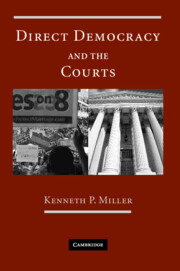Book contents
- Frontmatter
- Contents
- List of Tables and Figures
- Preface
- Introduction: A Clash of Rising Powers
- PART I THE QUEST FOR MAJORITY RULE
- PART II COUNTERING THE MAJORITY
- PART III THE MAJORITY STRIKES BACK
- Conclusion: A New Constitutional Equilibrium
- Appendix: Post-Election Initiative Invalidations
- References
- Index
- References
Conclusion: A New Constitutional Equilibrium
Published online by Cambridge University Press: 05 June 2012
- Frontmatter
- Contents
- List of Tables and Figures
- Preface
- Introduction: A Clash of Rising Powers
- PART I THE QUEST FOR MAJORITY RULE
- PART II COUNTERING THE MAJORITY
- PART III THE MAJORITY STRIKES BACK
- Conclusion: A New Constitutional Equilibrium
- Appendix: Post-Election Initiative Invalidations
- References
- Index
- References
Summary
First introduced as an “experiment in government” long ago, direct democracy has made a dramatic resurgence in recent decades. But, despite its expanding power and impact, direct citizen lawmaking has been largely contained by the constitutional system in which it operates. The people's rule has been limited by state and federal constitutional boundaries which, in turn, are enforced by courts.
Most importantly, the U.S. Constitution strictly confines direct democracy to the states. The Founders absolutely rejected direct popular rule and the Constitution prohibits direct citizen votes on questions of federal policy or constitutional design. Indeed, the United States is one of only five established democracies that have never held a national referendum – one of the enduring legacies of the founding. The Constitution also excludes citizens from directly exercising a state's federal constitutional powers. Citizens cannot directly trigger a call for a federal constitutional convention, nor ratify or reject federal constitutional amendments, nor instruct their representatives in Congress, nor, presumably, determine a state's rules for allocating electoral votes for President of the United States. The U.S. Supreme Court has determined that these decisions may be made, if at all, by legislatures, not by the people directly. Reformers from William Jennings Bryan to Ralph Nader have tried to introduce direct democracy at the national level. But, the exacting requirements for federal constitutional amendment make it unlikely that the United States will soon adopt any form of national direct democracy.
- Type
- Chapter
- Information
- Direct Democracy and the Courts , pp. 216 - 224Publisher: Cambridge University PressPrint publication year: 2009



